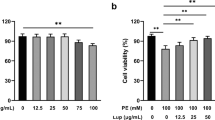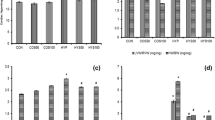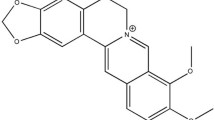Abstract
Purpose
Berberine was reported to exert beneficial effects on cardiac hypertrophy. However, its cellular and molecular mechanisms still remained unclear.
Methods
Cardiac hypertrophy was induced in male Sprague-Dawley (SD) rats by transverse aorta constriction (TAC), with or without 6-week treatment of berberine. Echocardiography was performed to evaluate cardiac function. Rats were then sacrificed for histological assay, with detection for proteins and mRNA. H9c2 cells were pretreated with berberine of different concentrations (0, 1 μM, and 10 μM), followed by treatment with 2 μM norepinephrine (NE). Cells of different groups were measured for cell surface area, with mRNA detected by qRT-PCR and proteins by western blot.
Results
Compared with the sham group, rats of the TAC group showed significantly increased cardiac hypertrophy and fibrosis, which could be ameliorated by treatment with berberine. Western blot showed that mammalian target of rapamycin (mTOR) signaling-related protein expressions, including phospho-mTOR, phospho-4EBP1, and phospho-p70 S6K (Thr389), but not phospho-p70 S6K (Ser371), were significantly increased in the TAC group, which were inhibited by berberine treatment. H9c2 cells were treated with NE to induce hypertrophy with increased cell surface area and mRNA expressions of anp and bnp. Berberine of 10 μM, but not 1 μM, significantly ameliorated NE-induced hypertrophy and inhibited protein expressions of mTOR signaling pathway similar to those in the rat model.
Conclusions
Berberine can exert cardioprotective effects on both pressure-overloaded cardiac hypertrophy and failure in vivo and NE-induced hypertrophy in vitro. Our results suggest berberine could be a potential treatment for patients with cardiac hypertrophy and failure.





Similar content being viewed by others
References
Akintoye E, Briasoulis A, Egbe A, Dunlay SM, Kushwaha S, Levine D, et al. National trends in admission and in-hospital mortality of patients with heart failure in the United States (2001-2014). J Am Heart Assoc. 2017;6(12):e006955.
Ponikowski P, Voors AA, Anker SD, Bueno H, Cleland JG, Coats AJ, et al. 2016 ESC guidelines for the diagnosis and treatment of acute and chronic heart failure: the task force for the diagnosis and treatment of acute and chronic heart failure of the European Society of Cardiology (ESC). Developed with the special contribution of the heart failure association (HFA) of the ESC. Eur J Heart Fail. 2016;18(8):891–975.
Heart Failure Group of Chinese Society of Cardiology of Chinese Medical Association, Chinese Heart Failure Association of Chinese Medical Doctor Association, Editorial Board of Chinese Journal of Cardiology. Chinese guidelines for the diagnosis and treatment of heart failure 2018. Zhonghua Xin Xue Guan Bing Za Zhi. 2018;46(10):760–89.
Tham YK, Bernardo BC, Ooi JY, Weeks KL, McMullen JR. Pathophysiology of cardiac hypertrophy and heart failure: signaling pathways and novel therapeutic targets. Arch Toxicol. 2015;89(9):1401–38.
Chen K, Rekep M, Wei W, Wu Q, Xue Q, Li S, et al. Quercetin prevents in vivo and in vitro myocardial hypertrophy through the proteasome-GSK-3 pathway. Cardiovasc Drugs Ther. 2018;32(1):5–21.
Gogiraju R, Bochenek ML, Schafer K. Angiogenic endothelial signaling in cardiac hypertrophy and heart failure. Front Cardiovasc Med. 2019;6:20.
Liu D, Meng X, Wu D, Qiu Z, Luo H. A natural isoquinoline alkaloid with antitumor activity: studies of the biological activities of berberine. Front Pharmacol. 2019;10:9.
Khin-Maung-U, Myo-Khin, Nyunt-Nyunt-Wai, Aye-Kyaw, Tin-U. Clinical trial of berberine in acute watery diarrhoea. Br Med J (Clin Res Ed). 1985;291(6599):1601–5.
Caliceti C, Franco P, Spinozzi S, Roda A, Cicero AF. Berberine: new insights from pharmacological aspects to clinical evidences in the management of metabolic disorders. Curr Med Chem. 2016;23(14):1460–76.
Feng X, Sureda A, Jafari S, Memariani Z, Tewari D, Annunziata G, et al. Berberine in cardiovascular and metabolic diseases: from mechanisms to therapeutics. Theranostics. 2019;9(7):1923–51.
Wei X, Luo L, Chen J. Roles of mTOR signaling in tissue regeneration. Cells. 2019;8(9):1075.
Simioni C, Martelli AM, Zauli G, Melloni E, Neri LM. Targeting mTOR in acute lymphoblastic leukemia. Cells. 2019;8(2):190.
Kou X, Chen D, Chen N. Physical activity alleviates cognitive dysfunction of Alzheimer’s disease through regulating the mTOR signaling pathway. Int J Mol Sci. 2019;20(7):1591.
Kim LC, Cook RS, Chen J. mTORC1 and mTORC2 in cancer and the tumor microenvironment. Oncogene. 2017;36(16):2191–201.
Chakrabarti P, Kandror KV. The role of mTOR in lipid homeostasis and diabetes progression. Curr Opin Endocrinol Diabetes Obes. 2015;22(5):340–6.
Perl A. mTOR activation is a biomarker and a central pathway to autoimmune disorders, cancer, obesity, and aging. Ann N Y Acad Sci. 2015;1346(1):33–44.
Aciarretta S, Forte M, Frati G, Sadoshima J. New insights into the role of mTOR signaling in the cardiovascular system. Circ Res. 2018;122(3):489–505.
Shen Z, Zhang Z, Wang X, Yang K. VEGFB-VEGFR1 ameliorates Ang II-induced cardiomyocyte hypertrophy through Ca2+-mediated PKG 1 pathway. J Cell Biochem. 2018;119(2):1511–20.
Mirhadi E, Rezaee M, Malaekeh-Nikouei B. Nano strategies for berberine delivery, a natural alkaloid of Berberis. Biomed Pharmacother. 2018;104:465–73.
Hu X, Zhang Y, Xue Y, Zhang Z, Wang J. Berberine is a potential therapeutic agent for metabolic syndrome via brown adipose tissue activation and metabolism regulation. Am J Transl Res. 2018;10(11):3322–9.
Zhu ML, Yin YL, Ping S, Yu HY, Wan GR, Jian X, et al. Berberine promotes ischemia-induced angiogenesis in mice heart via upregulation of microRNA-29b. Clin Exp Hypertens. 2017;39(7):672–9.
Liu L, Liu J, Huang Z, Yu X, Zhang X, Dou D, et al. Berberine improves endothelial function by inhibiting endoplasmic reticulum stress in the carotid arteries of spontaneously hypertensive rats. Biochem Biophys Res Commun. 2015;458(4):796–801.
Yu Y, Zhang M, Hu Y, Zhao Y, Teng F, Lv X, et al. Increased bioavailable berberine protects against myocardial ischemia reperfusion injury through attenuation of NFκB and JNK signaling pathways. Int Heart J. 2018;59(6):1378–88.
Zhao GL, Yu LM, Gao WL, Duan WX, Jiang B, Liu XD, et al. Berberine protects rat heart from ischemia/reperfusion injury via activating and attenuating endoplasmic reticulum stress. Acta Pharmacol Sin. 2016;37(3):354–67.
Hang W, He B, Chen J. Berberine ameliorates high glucose-indcued cardiomyocte injury via AMPK signaling activation to stimulate mitochondrial biogenesis and rstore autophagic flux. Front Pharmacol. 2018;9:1121.
Dong S, Zhang S, Chen Z, Zhang R, Tian L, Cheng L, et al. Berberine could ameliorate cardiac dysfunction via interfering myocardial lipidomic profiles in the rat model of diabetic cardiomyopathy. Front Physiol. 2018;9:1042.
Zeng Z, Pan Y, Wu W, Li L, Wu Z, Zhang Y, et al. Myocardial hypertrophy is improved with berberine treatment via long non-coding RNA MIAT-mediated autophagy. J Pharm Pharmacol. 2019;71(12):1822–31.
Mercurio V, Pucci G, Bosso G, Fazio V, Battista F, Iannuzzi A, et al. A nutraceutical combination reduces left ventricular mass in subjects with metabolic syndrome and left ventricular hypertrophy: a multicenter, randomized, double-blind, placebo-controlled trial. Clin Nutr. 2019 Jul 19. https://doi.org/10.1016/j.clnu.2019.06.026.
Wang Y, Qu H, Liu J. P66Shc Deletion ameliorates oxidative stress and cardiac dysfunction in pressure overload-induced heart failure. J Card Fail. 2019 sep 16. https://doi.org/10.1016/j.cardfail.2019.09.003.
Huang Z, Shu J, Jiang W, Jiang M, Lu Y, Dai H, et al. Regulator of G protein signaling 6 facilities cardiac hypertrophy by activating apoptosis signal-regulating kinase 1-p38/c-JUN N-terminal kinase 1/2 signaling. J Am Heart Assoc. 2018;7(19):e009179.
Li Q, Wei G, Tao T. Leukocyte immunoglobulin-like receptor B4 (LILRB4) negatively mediates the pathological cardiac hypertrophy by suppressing fibrosis, inflammation and apoptosis via the activation of NF-κB signaling. Biochem Biophys Res Commun. 2019;209(1):16–23.
Shimizu I, Minamino T. Physiological and pathological cardiac hypertrophy. J Mol Cell Cardiol. 2016;97:245–62.
Thakur A, Alam MJ, Ajayakumar MR, Ghaskadbi S, Sharma M, Goswami SK. Norepinephrine-induced apoptotic and hypertrophic responses in H9c2 cardiac myoblasts are characterized by different repertoire of reactive oxygen species generation. Redox Biol. 2015;5:243–52.
Lee CY, Lee J, Seo HH, Shin S, Kim SW, Lee S, et al. TAK733 attenuates adrenergic receptor-mediated cardiomyocyte hypertrophy via inhibiting ErkThr188 phosphorylation. Clin Hemorheol Microcirc. 2019;72(2):179–87.
Wang K, Feng X, Chai L, Cao S, Qiu F. The metabolism of berberine and its contribution to the pharmacological effects. Drug Metab Rev. 2017;49(2):139–57.
Tan XS, Ma JY, Feng R, Ma C, Chen WJ, Sun YP, et al. Tissue distribution of berberine and its metabolites after oral administration in rats. PLoS One. 2013;8(10):e77969.
Sciarretta S, Volpe M, Sadoshima J. Mammalian target of rapamycin signaling in cardiac physiology and disease. Circ Res. 2017;114(3):549–64.
Magrys A, Bogut A, Kielbus M, Olender A. The role of the PI3K/mTOR signaling pathway in Staphylococcus epidermidis small colony variants intracellular survival. Immunol Investig. 2018;47(3):251–63.
Johnson CE, Tee AR. Exploiting cancer vulnerabilities: mTOR, autophagy, and homeostatic imbalance. Essays Biochem. 2017;61(6):699–710.
Ma X, Yao J, Yue Y, Du S, Qin H, Hou J, et al. Rapamycin reduced pulmonary vascular remodelling by inhibiting cell proliferation via Akt/mTOR signalling pathway down-regulation in the carotid artery-jugular vein shunt pulmonary hypertension rat model. Interact Cardiovasc Thorac Surg. 2017;25(2):206–11.
Ikeda M, Ide T, Fujino T, Matsuo Y, Arai S, Saku K, et al. The Akt-mTOR axis is a pivotal regulator of eccentric hypertrophy during volume overload. Sci Rep. 2015;5:15881.
Sciarretta S, Zhai P, Maejima Y, Del Re DP, Nagarajan N, Yee D, et al. mTORC2 regulates cardiac response to stress by inhibiting MST1. Cell Rep. 2015;11(1):125–36.
Alam MJ, Gupta R, Mahapatra NR, Goswami SK. Catestatin reverses the hypertrophic effects of norepinephrine in H9c2 cardiac myoblasts by modulating the adrenergic signaling. Mol Cell Biochem. 2020;464(1–2):205–19.
Saleem N, Goswami SK. Activation of adrenergic receptor in H9c2 cardiac myoblasts co-stimulates Nox2 and the derived ROS mediate the downstream responses. Mol Cell Biochem. 2017;436(1–2):167–78.
Li J, Wu W, Xin Y, Zhao M, Liu X. Inhibition of Nogo-B promotes cardiac hypertrophy via endoplasmic reticulum stress. Biomed Pharmacother. 2018;104:193–203.
Acknowledgments
We thank Zhenkun Guan and Nurul Farhanah Binte Abdul Latif from Guangzhou Medical University for the English writing revision.
Funding
This study was funded by the Medical Research Foundation of Guangdong Province, China (grant number A2018307) and the Research Foundation for Doctors and Returned Overseas Scholars of Guangzhou Medical University, China (grant number 2016C19).
Author information
Authors and Affiliations
Corresponding authors
Ethics declarations
Conflict of Interest
The authors declare that they have no conflict of interest.
Ethical Approval
All applicable international, national, and/or institutional guidelines for the care and use of animals were followed. All procedures for rats were in accordance with the Guide for the Care and Use of Laboratory Animals and approved by the Animal Ethics and the Use Committee of the Second Affiliated Hospital of Guangzhou Medical University.
Additional information
Publisher’s Note
Springer Nature remains neutral with regard to jurisdictional claims in published maps and institutional affiliations.
Rights and permissions
About this article
Cite this article
Chen, X., Jiang, X., Cheng, C. et al. Berberine Attenuates Cardiac Hypertrophy Through Inhibition of mTOR Signaling Pathway. Cardiovasc Drugs Ther 34, 463–473 (2020). https://doi.org/10.1007/s10557-020-06977-z
Published:
Issue Date:
DOI: https://doi.org/10.1007/s10557-020-06977-z




